Intel Dual-Core Mobile Ivy Bridge Launch and i5-3427U Ultrabook Review
by Jarred Walton on May 31, 2012 12:01 AM EST- Posted in
- Laptops
- CPUs
- Intel
- Ivy Bridge
- Ultrabook
Ivy Bridge Ultrabook Quick Sync and 3DMark Performance
Buying a laptop isn’t just about generic office and Internet applications, naturally. Intel (and AMD and NVIDIA) have been pushing video and image processing applications as increasingly important, in our digital Facebook/YouTube/etc. world. We’ve looked at two video transcoding applications from ArcSoft and CyberLink several times already, but let’s see how Ivy Bridge Ultrabooks rate. We’ve run a video transcode converting a 3:43 minute 1080p24 video clip taken with a Nikon D3100 camera into a 720p video and timed how long the process takes.
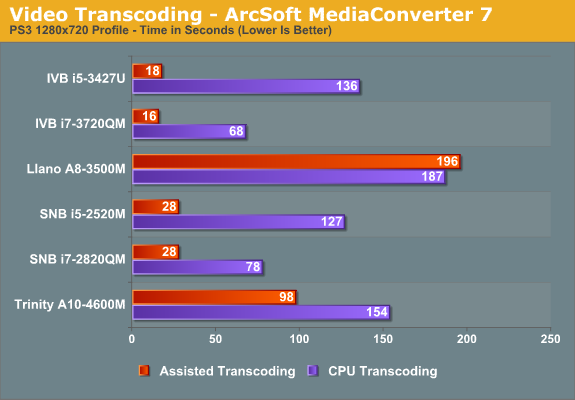
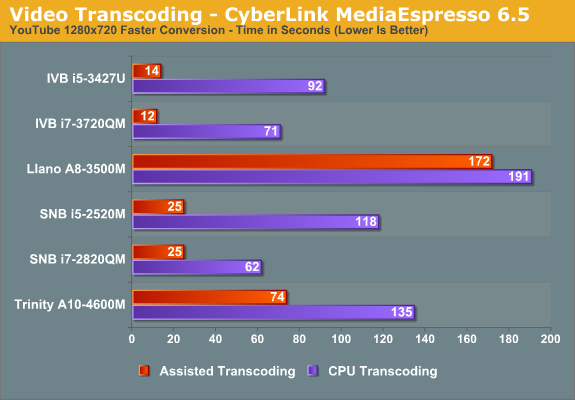
Quick Sync continues to be the undisputed champion of these two applications, beating out AMD’s accelerated transcode on Trinity by a factor of five. However, if you’re really into video transcoding and you want more control over quality, we don’t know many people who use MediaEspresso or MediaConverter. For free software, Handbrake is probably the most popular option right now, and as we showed previously, AMD has a beta OpenCL accelerated version of Handbrake that they’ve been working on where they can come very close to quad-core Ivy Bridge performance.
It remains to be seen when the public release of Handbrake will get such support, not to mention Intel and NVIDIA are going to be interested in getting the OpenCL version to run appropriately on their hardware. Still, it’s important to keep these other developments in mind. For now, the best quality transcodes still come by way of the CPU, and ULV Ivy Bridge offers better performance than AMD’s Trinity A10 in that case—never mind the standard voltage parts. We expect to see additional software companies start looking at ways to leverage OpenCL, GPUs, APUs, and Quick Sync to help with this sort of workload going forward.
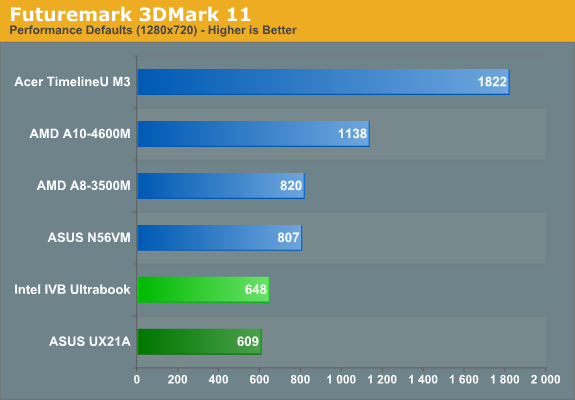
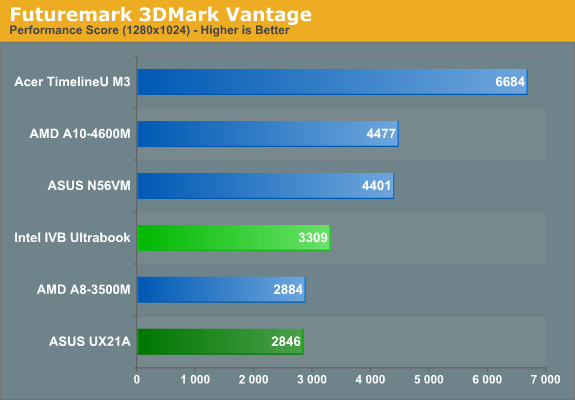
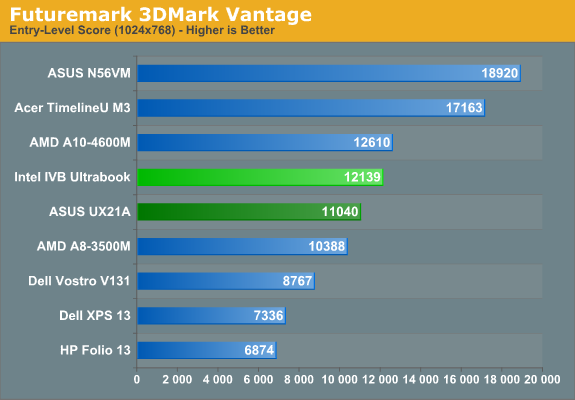
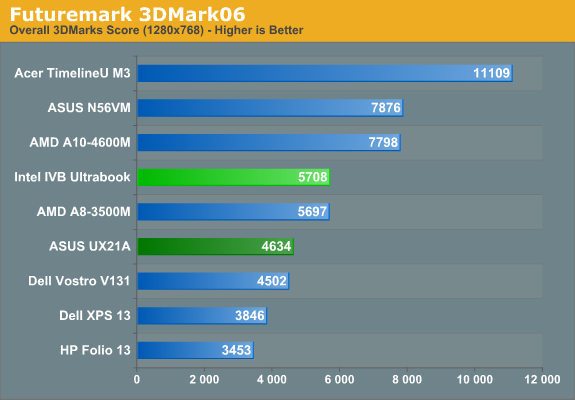
As for synthetic graphics performance, Intel has performed quite well in 3DMarks for several years now—we’d argue their 3DMark scores are often optimized far more than actual gaming performance. Still, 3DMarks are a nice way to compare across several generations of hardware, so we continue to run them on laptops. Again we see the UX21A trail the IVB ULV prototype, despite having a higher performance i7 CPU; thermal issues are the most likely cause, and the difference ranges from a rather minor 6% gap in 3DMark11 up to 23% in 3DMark06. Also interesting is that the quad-core i7-3720QM, which has a GPU that’s only clocked up to 9% higher, ends up leading the ULV IVB part by 25% (3DMark11) to as much as 33% or more! The extra—and faster—CPU cores might be a factor, but it’s also likely that the i7-3720QM is able to hit the maximum 1250MHz GPU clock far more often than the i5-3427U can hit its maximum 1150MHz clock.
Once we get beyond the Intel IGP comparisons, however, things don’t look nearly as good for ULV Ivy Bridge. Llano is around 25% faster in 3DMark11, though ULV IVB comes out ahead in the other results; Trinity on the other hand is 35-75% faster in the three main results (e.g. not counting 3DMark Vantage Entry, as that’s very low in terms of stressing the GPU). Again, the most interesting comparison is unfortunately one we can’t make yet: how will the A10-4655M 25W Trinity APU (with GPU clocks that are almost 30% lower than the 35W A10) compare with ULV IVB? We’ll have to take a wait and see approach on that one, but depending on the game it may or may not be a close matchup.










64 Comments
View All Comments
Ryan Smith - Thursday, May 31, 2012 - link
Price.ZeDestructor - Thursday, May 31, 2012 - link
And what's the difference in price? I shouldn't think its that much a big difference in between the two compared to, say, the CPU cost...JarredWalton - Thursday, May 31, 2012 - link
The chart we put together didn't include this information, but QS77 is targeted at SFF systems, so it has slightly lower power characteristics and it comes in a 22x22mm package instead of the 25x25mm packaging used on the other chipsets. Interestingly, even UM77 is 25x25mm, and that seems like the perfect chipset to have a smaller footprint.JarredWalton - Thursday, May 31, 2012 - link
Oh, nevermind: it's there. You just need to look for it.ZeDestructor - Thursday, May 31, 2012 - link
Still no price info though, I had to go Google it up :(QS77 is USD53 vs QM77 which is USD48.
To me eating 5$ worth of profit to gain some battery life is worth it, and also allows for smaller board designs. Once you factor in economies of scale, I don't see why the QS77 can't lose at least a further USD2 if the QM77 is cut out entirely and become even better value.
Source: http://laptoport.com/2011/12/28/intel-will-unveil-...
Its a good chart, just needs a price line ;)
JarredWalton - Thursday, May 31, 2012 - link
Intel didn't release pricing information, so I'd have to go to other sources to see what Intel has said in the past. Of course, it's basically meaningless to talk about chipset prices as the only people buying chipsets are the OEMs and motherboard manufacturers. Sadly, those are the same folks that will save $10 in most cases to ship a crappy LCD in place of something much better.thunderising - Thursday, May 31, 2012 - link
Wow, even with HD4000, IVB dual cores perform terribly in games.And even now, I'm pretty sure these are priced wayy above the old and new Llano Parts.
I give my vote to AMD's Trinity this round
JarredWalton - Thursday, May 31, 2012 - link
Don't jump ahead of the data: Dual-core Ivy Bridge ULV parts have generally weak performance in graphics. In a 17W TDP, it's very likely the maximum GPU clocks are not coming anywhere near 1150MHz on some titles. I suspect the standard voltage parts will be withing 5-10% of the quad-core parts for HD 4000 performance.As for AMD, their ULV/LV parts take some major GPU performance cuts as well. The A10-4655M will have GPU clocks that are 30% lower than the A10-4600M, while the A6-4455M has lower clocks and half as many Radeon cores. Given how far the A6 is cut back to fit in a 17W TDP, I don't expect it to fare much better on games.
ananduser - Thursday, May 31, 2012 - link
Well let's wait for a review first shall we ? :)JarredWalton - Thursday, May 31, 2012 - link
Sure, before we make any final statements, but based on the clocks and core counts we can certainly make a pretty good guess of where Trinity will rank with LV/ULV configurations. It's sort of like Brazos in that aspect, which is to say cutting the GPU or CPU down that far isn't going to help performance. On the compute side, though, funny things happen and compute doesn't always scale directly with core counts and clock speeds. Heck, look at the i5-3470 review from Anand: HD 2500 is sometimes 1/3 the performance of HD 4000. Ouch.Anyway, let's make some wagers. My guess on A6-4455M is that it will be about half as fast as the A10-4600M in games, while delivering about 80% of the single-threaded performance and less than half of the multi-threaded performance. The A10-4655M should do better, but it will probably still be 20-25% slower than A10-4600M for games, maybe 90% of the single-threaded performance, and 80% of the multi-threaded performance.